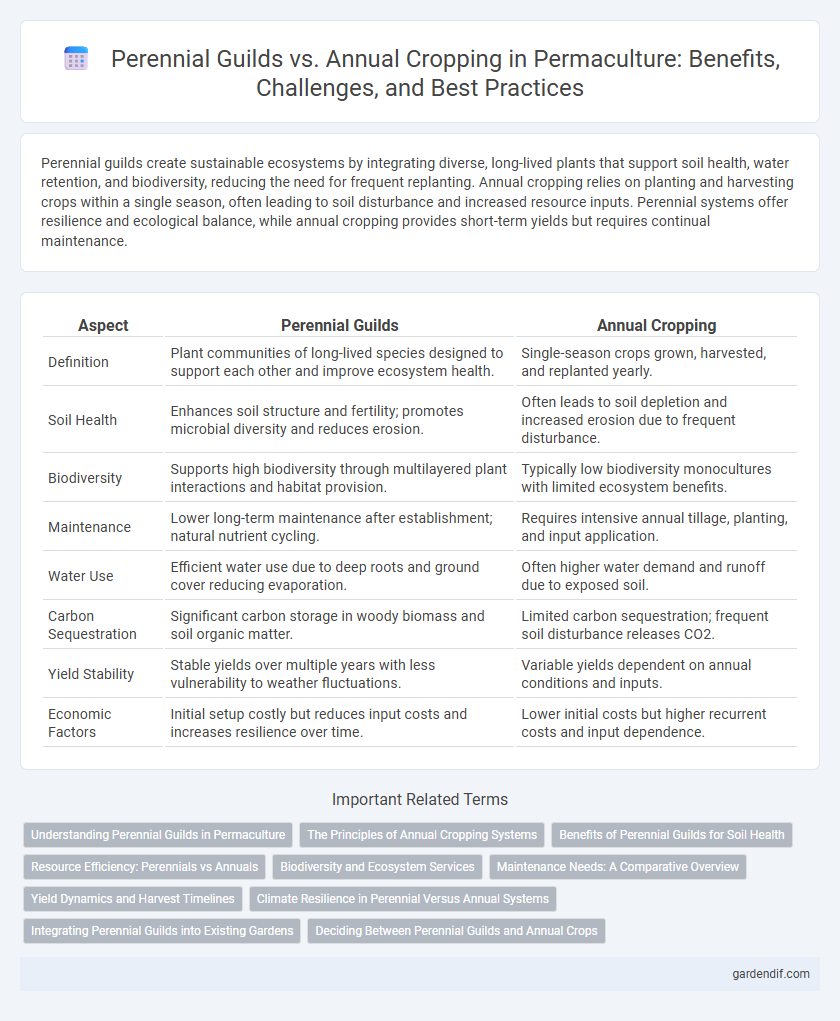
Perennial guilds vs annual cropping Illustration
Perennial guilds create sustainable ecosystems by integrating diverse, long-lived plants that support soil health, water retention, and biodiversity, reducing the need for frequent replanting. Annual cropping relies on planting and harvesting crops within a single season, often leading to soil disturbance and increased resource inputs. Perennial systems offer resilience and ecological balance, while annual cropping provides short-term yields but requires continual maintenance.
Table of Comparison
| Aspect | Perennial Guilds | Annual Cropping |
|---|---|---|
| Definition | Plant communities of long-lived species designed to support each other and improve ecosystem health. | Single-season crops grown, harvested, and replanted yearly. |
| Soil Health | Enhances soil structure and fertility; promotes microbial diversity and reduces erosion. | Often leads to soil depletion and increased erosion due to frequent disturbance. |
| Biodiversity | Supports high biodiversity through multilayered plant interactions and habitat provision. | Typically low biodiversity monocultures with limited ecosystem benefits. |
| Maintenance | Lower long-term maintenance after establishment; natural nutrient cycling. | Requires intensive annual tillage, planting, and input application. |
| Water Use | Efficient water use due to deep roots and ground cover reducing evaporation. | Often higher water demand and runoff due to exposed soil. |
| Carbon Sequestration | Significant carbon storage in woody biomass and soil organic matter. | Limited carbon sequestration; frequent soil disturbance releases CO2. |
| Yield Stability | Stable yields over multiple years with less vulnerability to weather fluctuations. | Variable yields dependent on annual conditions and inputs. |
| Economic Factors | Initial setup costly but reduces input costs and increases resilience over time. | Lower initial costs but higher recurrent costs and input dependence. |
Understanding Perennial Guilds in Permaculture
Perennial guilds in permaculture consist of diverse plant species that support each other through complementary functions such as nitrogen fixation, pest control, and nutrient accumulation, creating a resilient and self-sustaining ecosystem. Unlike annual cropping, which relies on single-season plants and requires frequent soil disturbance, perennial guilds enhance soil health, reduce erosion, and promote biodiversity by maintaining continuous ground cover year-round. Understanding the principles and structure of perennial guilds enables gardeners and farmers to design agroecosystems that offer long-term productivity and ecological balance.
The Principles of Annual Cropping Systems
Annual cropping systems rely on crop rotation, soil disturbance, and synthetic inputs to maximize short-term yields, often depleting soil health. These systems emphasize fast-growing crops harvested within a single season, requiring frequent replanting and intensive management. In contrast, perennial guilds build long-term soil fertility and ecosystem resilience through diverse, multi-layered plants that regenerate year after year without repeated tilling.
Benefits of Perennial Guilds for Soil Health
Perennial guilds enhance soil health by promoting deep root systems that improve soil structure, increase organic matter, and boost microbial diversity, leading to greater nutrient cycling and water retention. Unlike annual cropping, these stable ecosystems reduce soil erosion and minimize disturbance, which supports long-term soil fertility and resilience. The multilayered plant diversity in perennial guilds creates synergistic interactions that sustain soil vitality year-round.
Resource Efficiency: Perennials vs Annuals
Perennial guilds enhance resource efficiency by maintaining continuous root systems that improve soil structure, water retention, and nutrient cycling compared to annual cropping. Deep-rooted perennials access nutrients and moisture from subsoil layers, reducing the need for external inputs and minimizing erosion. In contrast, annual crops rely on frequent soil disturbance and replanting, leading to higher energy expenditure and resource depletion.
Biodiversity and Ecosystem Services
Perennial guilds enhance biodiversity by integrating diverse, long-lived plant species that provide continuous habitat and resources for pollinators, soil microbes, and beneficial insects, creating resilient ecosystems. In contrast, annual cropping often reduces biodiversity due to frequent soil disturbance and monoculture practices, limiting habitat variety and ecosystem services. The stable structure of perennial guilds supports improved nutrient cycling, soil stabilization, and water retention, leading to sustainable ecosystem benefits absent in most annual systems.
Maintenance Needs: A Comparative Overview
Perennial guilds require lower maintenance compared to annual cropping due to their established root systems and natural resilience, reducing the need for frequent soil disturbance and replanting. Annual cropping demands consistent inputs such as tilling, seeding, and pest control each growing season, increasing labor and resource use. This intrinsic difference leads to enhanced sustainability and reduced long-term effort in perennial systems versus the more intensive upkeep required by annual agriculture.
Yield Dynamics and Harvest Timelines
Perennial guilds offer stable yield dynamics by providing continuous harvests over multiple years without the need for replanting, reducing soil disturbance and enhancing ecosystem resilience. In contrast, annual cropping delivers rapid, high-yield outputs within a single season but requires frequent soil tilling and replanting, which can degrade soil health over time. Harvest timelines in perennial systems are extended and staggered, resulting in diverse food availability, while annual crops produce a concentrated yield peak with shorter harvest windows.
Climate Resilience in Perennial Versus Annual Systems
Perennial guilds in permaculture enhance climate resilience by promoting deeper root systems that improve soil structure, increase water retention, and reduce erosion compared to annual cropping systems. The diversity within perennial guilds supports microclimates and fosters beneficial microbial activity, which enhances nutrient cycling and resistance to extreme weather events. Annual cropping often relies on frequent soil disturbance and monocultures, leaving ecosystems more vulnerable to drought, floods, and temperature fluctuations.
Integrating Perennial Guilds into Existing Gardens
Integrating perennial guilds into existing gardens enhances soil health by fostering diverse root structures and supporting beneficial microbial communities, which contrasts with the soil disruption caused by annual cropping. Perennial guilds promote resilience through continuous biomass, nutrient cycling, and habitat for pollinators, reducing the need for synthetic inputs commonly used in annual systems. Effective integration involves selective placement of nitrogen-fixing plants, dynamic accumulators, and insectary species to create self-sustaining polycultures that improve productivity and ecological balance.
Deciding Between Perennial Guilds and Annual Crops
Perennial guilds establish diverse, self-sustaining plant communities that improve soil health through deep root systems and natural nutrient cycling, reducing the need for external inputs. Annual cropping demands intensive soil preparation and frequent replanting, often leading to higher soil erosion and nutrient depletion. Choosing between perennial guilds and annual crops depends on long-term land stability goals and the desired balance between maintenance effort and ecosystem resilience.
Perennial guilds vs annual cropping Infographic

 gardendif.com
gardendif.com